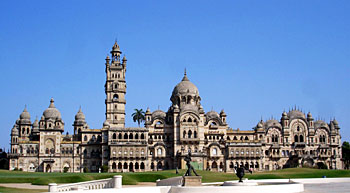 Indo-Saracenic architecture in India came into prominence during the later parts of the nineteenth century. With the coming of this pattern, a majority of the patrons felt that there was requirement to be a part of a particular style which at times led to a highly inventive blending of Western and Oriental design.
Indo-Saracenic architecture in India came into prominence during the later parts of the nineteenth century. With the coming of this pattern, a majority of the patrons felt that there was requirement to be a part of a particular style which at times led to a highly inventive blending of Western and Oriental design.
The buildings of Major Charles Mant and, in particular, his palaces at Kolhapur and Baroda were clever attempts at an intermingling of styles and forms, but not all were characterized by either discipline or restraint. The most outrageous, the Amba Vilas palace at Mysore, by Henry Irwin, and the Laxhmi Vilas palace at Baroda, completed by Robert Chisholm, have been described as `orgiastic shopping sprees in the bargain basement of architecture`. The best, the Viceroy`s House in New Delhi, by Sir Edwin Lutyens, is simply one of the finest buildings constructed in the twentieth century, the ultimate resolution of a series of stylistic experiments in the blending of Eastern and Western architecture which formed an extraordinary heritage of palace buildings not found anywhere in the world.
In the later half of the 19th century the revivalists gained ground and there was also a good reason for it. Victorian Indo-Saracenic buildings were part of the British response to rising Indian nationalism. Paradoxically, they helped to foster it by reviving a cultural awareness of the rich and glorious past of India. They were sophisticated symbols of the Imperial presence. The outward camouflage may be Indian and Indian labour may have been used, but the designs, plans and overall control remained British, in much the same way as the British remained the power behind the princely states. This transmutation of a national Gothic image into Indo-Saracenic forms is an indication of how the Raj began to adapt its image to make itself more palatable to the rapidly rising middle class of India.
Examples of Indo-Saracenic architecture can be found all over India. A number of the 19th century palaces in the native states were designed in this style by accomplished practitioners, like Major Charles Mant at Kolhapur or Sir Samuel Swinton Jacob at Bikaner. One of the most prolific architects in this style was the versatile Robert Fellowes Chisholm, who designed the Presidency College and Senate House at Chennai (Madras) and the vast, rambling Laxmi Vilas Palace at Vadodara (Baroda). However, the greatest Indo-Saracenic building in Chennai is not by Chisholm but by his successor, W. Brassingham, and Henry Irwin, the architect of Viceregal Lodge, Shimla. The Madras Law Courts, constructed between 1888 and 1892, were one of the high points of Indo-Saracenic architecture in India; `a Romantic confection of multi-coloured Mughal domes, Buddhist shapes, canopied balconies and arcaded verandahs, crowned by a bulbous domed minaret which forms a lighthouse`. Irwin also designed the exquisite Victoria Memorial Halland Technical Institute, based on the great Buland Darwaza, the famous gateway of Akbar at Fatehpur Sikri.
 At Hyderabad, in the state of Andhra Pradesh, the English architect Vincent Eseh adorned the city with a large number of elegant public buildings, including the High Court and Osmania General Hospital. Here, a blending of Muslim and Hindu styles was used to represent the harmony between the two communities when the risk of sectarian strife was a constant worry.
At Hyderabad, in the state of Andhra Pradesh, the English architect Vincent Eseh adorned the city with a large number of elegant public buildings, including the High Court and Osmania General Hospital. Here, a blending of Muslim and Hindu styles was used to represent the harmony between the two communities when the risk of sectarian strife was a constant worry.
In the south, at Mysore, Henry lrwin planned the incomparable Amba Vilas Palace for the maharaja, with an onion-dome and minaret which nearly resembled those on the Law Courts at Chennai. But the most scholarly exponent of revivalist architectural styles was Colonel Sir Samuel Swinton Jacob, who did an enormous amount of work in Ajmer, Jaipur and throughout Raj as than, building on the pioneering work in Indian Arts and Crafts at Mumbai by John Lockwood Kipling, the father of Rudyard Kipling. The effective conservation of many Indian monuments was one of the most enduring legacies of the British Rule in India. The Archaeological Survey of India was founded in the year 1861, but as early as 1808 the government had concerned itself with the preservation of the Taj Mahal. It was Lord Curzon who established the present framework of statutory control with the Ancient Monuments Preservation Act of 1904.



















